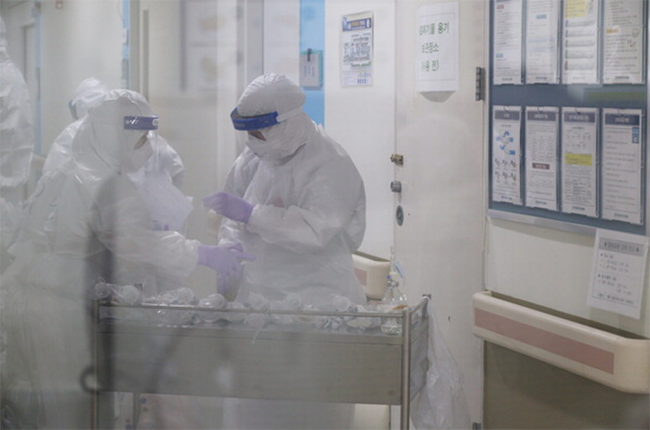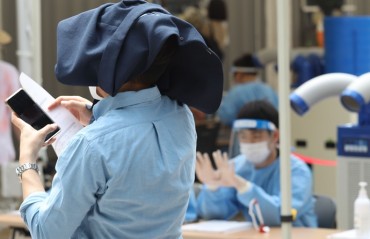
Medical staff at Busan Medical Center, at the forefront of the battle against COVID-19, are getting ready to deliver intravenous fluids to patients admitted in the negative pressure ward corridor. (Image provided by Busan Medical Center)
SEOUL, Oct. 11 (Korea Bizwire) – Amidst the peak of the COVID-19 pandemic, South Korea stood out as an exemplary nation in its approach to combating the novel coronavirus. In a May 2020 article focused on global health policy, CNN highlighted South Korea and Germany as shining examples of how to navigate a world transformed by COVID-19.
South Korea earned accolades for its proficient management of every phase of the COVID-19 outbreak, from its inception to the outbreak’s peak, the mitigation of its spread, and the subsequent easing of lockdown measures.
This success was attributed to a combination of extensive testing, robust contact tracing efforts, stringent public health protocols, and the adept use of digital technology. Remarkably, South Korea managed to contain the outbreak without resorting to a full-scale lockdown.
Nonetheless, the pandemic took a heavy toll on small businesses and self-employed individuals. An analysis based on credit card data revealed a significant decline in sales volume for these groups throughout 2020.
However, the impact of COVID-19 extended beyond these economic casualties. Public hospitals across the nation, which had made considerable sacrifices for the greater good during the pandemic, now find themselves confronting a dire crisis in the post-pandemic era, as reported by SisaIN, a publication renowned for its comprehensive coverage of current affairs.
Public hospitals in South Korea constitute just 5 percent of the country’s healthcare facilities. Nevertheless, most of the 35 local hospitals are grappling with the repercussions of COVID-19 even after the pandemic has subsided. These hospitals played a pivotal role in South Korea’s COVID-19 recovery by accommodating a majority of COVID-19 hospitalizations.
Unfortunately, while these hospitals were dedicated to treating COVID-19 patients, those with other medical conditions were redirected to alternative healthcare institutions. As a result, they now contend with vacant beds.
As of June of this year, the average bed occupancy rate at local hospitals plummeted to a mere 46.4 percent, down from 80.5 percent in 2019. Moreover, the occupancy rate for patients who had been transferred during the pandemic has significantly declined. The diminishing occupancy rate naturally translates into a loss of revenue for hospitals.
Adding to their woes, the compensation payments for COVID-19 recovery period losses to public hospitals concluded this year. The government’s budget proposal for the next year indicates a 6.3 percent reduction in funding for the “Strengthening the Publicity of Regional Base Hospitals” project, which supports local hospitals.

In this photo, a medical staff member at Seoul Medical Center, which has been designated as a dedicated COVID-19 hospital, checks the status of patients in the negative pressure ward on a monitor. (Image provided by the Seoul Metropolitan Government)
Public hospitals account for only 9 percent of Korea’s total healthcare supply system in terms of beds, but during COVID-19, they were responsible for nearly 70 percent of inpatient care for COVID-19 patients.
In fact, at the beginning of the COVID-19 outbreak in 2020, four of Seoul’s 12 major public hospitals—Seoul Medical Center (187), Boramae Hospital (138), Seonam Hospital (100), and Seobuk Hospital (21)—treated 446 people, or 71 percent of Seoul’s confirmed cases, and discharged 225. By some calculations, four out of every five confirmed cases benefited from Seoul’s public healthcare infrastructure.
The dedicated service of public hospitals during the pandemic is poignantly illustrated by the situation at Pocheon Hospital, Gyeonggi Provincial Medical Center. Adorning the hospital director’s office is a ribbon of recognition presented by the South Korean Prime Minister.
The hospital received 11 awards from the central government during the COVID-19 pandemic. However, post-pandemic, Pocheon Hospital’s occupancy rate languished at around 40 percent as of September, and monthly losses have surged to 1 billion won.
In the wake of the COVID-19 pandemic, many small businesses and public hospitals, which made significant sacrifices by adhering to the government’s quarantine guidelines, now find themselves at risk of extinction.
M. H. Lee (mhlee@koreabizwire.com)






